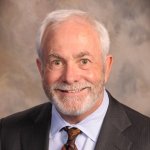It seems like everywhere you turn experts and thought leaders are predicting the future of healthcare and health IT. Luckily, at our radio station Healthcare NOW Radio, we have our very own gurus, our hosts, who took time to share their thoughts on what’s to come in 2023.
 Jim Tate, President, EMR Advocate
Jim Tate, President, EMR Advocate
Twitter: @JimTate
Host of The Tate Chronicles
- TEFCA has been a long time coming but I’m expecting some puzzle pieces to start falling into place. Is this the long-awaited delivery of a process to meet the promise of interoperability on a wide scale? Here’s hoping.
- The number of EHR vendors who throw in the towel due to increased technical and compliance requirements will increase.
- I expect widespread confusion related to the real-world implementation of the FHIR API requirement. Lots of workflows to design and best practices have yet to be determined.
 Frederic S. Goldstein, President and Founder, Accountable Health, LLC
Frederic S. Goldstein, President and Founder, Accountable Health, LLC
Twitter: @fsgoldstein
Co-Host of PopHealth Week
2023 will be year that Population Health focuses on doing something, not just talking about interventions to address the Social Influencers of Health. In Health IT, AI and Machine Learning will have a substantial impact on operational efficiencies in areas such as document scanning, fraud and abuse identification, and other task-oriented healthcare processes. There will continue to be efforts to utilize AI/ML in the areas of clinical support and disease identification but that will be much less effective and accepted. And finally in the area of healthcare financing, how to pay for the new multi-million-dollar FDA approved gene therapies will create a major issue for employers and payers and require the development of innovative financing mechanisms to cover the risk.
 Matt Fisher, General Counsel, Carium
Matt Fisher, General Counsel, Carium
Twitter: @Matt_R_Fisher
Host of Healthcare de Jure
The healthcare industry will accelerate its move away from point solutions and expand the use of platforms that can provide a single solution to build from. Entrenching the use of a single platform should facilitate a more straightforward build and implementation process and foster a better experience for patients.
The unified platform that fits most if not all use cases will also help organizations with the ongoing, though still too slow, transition to value based care models. A good platform can bridge the two approaches by enabling a fee for service approach while instilling engagement approaches that will actually be better served in value based care arrangements.
 Tom Foley
Tom Foley
Twitter: @FoleyTom
Host of The Virtual Shift
- Due to the financial challenges of health systems the market shifts attention from telehealth (video only) to further embrace more effective virtual care services (ie. RPM, CCM, PCM) enhance patient engagement – reducing costs and improving outcomes (clinically and financially)
- Resource challenges coupled with ongoing infectious condition awareness/mitigation strategies will further drive adoption of in-home care services.
- 2023 is the year the home cements itself as a viable setting of care.
- The ONC finally realizes EHRs probabilistic patient record matching algorithm is a major flaw in its interoperability strategy, finally recognizes this flaw creates patient harm (errors); hence forces reform.
 Dr. Nick van Terheyden aka Dr. Nick
Dr. Nick van Terheyden aka Dr. Nick
Twitter: @drnic1
Host of The Incrementalist
- PBMs and Drug Pricing – Expect a renewed focus on the huge disparities in drug prices levied on the American public. The PBM black box approach and complex mechanisms used to conceal and confuse will come under increasing scrutiny as dissatisfaction rises.
- Blockchain – the excitement might subdue for a few years but there remains value in specific use cases. If the smart contracting capability could rise above the noise and detritus left by the FTX debacle we could see some real automation of the inexorably painful and costly pre-authorization process. This of course requires that all parties want the process to be efficient and that question remains firmly up in the air without some legislative oversight IMO
- Meta bah humbug – virtual worlds are way too far over their skis, but sitting in the background is some valuable training capability and clear use cases for virtualization for extending care and healthcare capabilities to remote and underserved areas. Focus on that and not if you can see someone’s legs in the virtual world.
- Speech enablement, despite the experience of Amazon and the losses it has from the Alexa solution, remains a central solution and capability that continues to offer new and exciting capabilities. It’s not just navigation and clinical documentation but is increasingly showing promise for clinical diagnosis with clinical disease biomarkers.
 Gil Bashe, Managing Partner, Chair Global Health, FINN Partners
Gil Bashe, Managing Partner, Chair Global Health, FINN Partners
Twitter: @Gil_Bashe
Host of Health UnaBASHEd
- Environmental impact is a domino of disease and despair. Carbon footprint and ecological impact will rise near the top of the Fortune 500 corporate agenda. Communicators are the clarion bell that reminds C-Suite decision-makers that the planet doesn’t need people, but people need the planet. Companies know that they must track their performance and share data with employees, customers, shareholders and policymakers. Health information is the front-office link for these influential audiences to rally people toward climate action goals.
- After the global COP27 Summit, more and more C-Suite leaders will turn to their chief communication officers and financial officers to engage on commitments at this UN-sponsored gathering. For a good reason. Over 150 million global citizens are displaced due to climate change, and an equal number are undernourished, leading to illnesses and financial ruin. There is no more kicking that can down humanity’s road hoping someone else – a future corporate CEO or Federal administration – will shoulder responsibility. That clock is ticking. Health information will play a far more significant role than patient data and billing. Now, C-Suite leaders will look for information to predict health hotspots that alert us to pending public health dangers.
- The planet doesn’t need people – but people need the planet. Large and small companies increasingly recognize that purpose and social impact are far more than “nice things to do.” Customers and shareholders see that monitoring groups such as Clean Creatives spotlight companies with questionable practices that negatively influence public health. Expect that spotlight light to be even brighter in 2023. Corporate reputation and social responsibility are must-do market differentiators in a more challenging economic climate. In a tougher competition for market voice, employee and customer reputation will be a high priority.
 Beth Friedman, Sr. Partner, FINN Partners
Beth Friedman, Sr. Partner, FINN Partners
Twitter: @HealthITPR
A Host of FINN Voices
Our industry continues to experience a tsunami of staffing shortages and clinician burnout. These two challenges alone will propel hospitals, health systems and medical groups to accelerate automation and digital transformation in the year ahead. From revenue cycle to care coordination, we’ll see dramatic advancements in technology applications to relieve workforce and administrative burdens from healthcare, one use case at a time.
Look to innovation centers within our nation’s most progressive hospitals and health systems to lead the charge. Their investments will be strategic, demonstrate a positive impact and always work with technology incumbents. Successful organizations will also employ innovative health IT partnerships, prioritize internal stakeholders, and integrate with existing EHRs and other systems.
Who knows? The year ahead may even usurp 2009 to 2014’s hockey stick of EMR and EHR adoption that occurred in the wake of the HITECH Act. 2023 will be a fast-paced and dynamic year in digital health.
 Gregg Masters, Founder & Managing Director, Health Innovation Media
Gregg Masters, Founder & Managing Director, Health Innovation Media
Twitter: @GreggMastersMPH
Producer and Co-host of Health Unabashed
Despite the determined effort to move the healthcare economy from its silo-ed DNA overly dependent on the ‘do more, to earn more’ economy of fee-for-services incentives, too many last gaspers of preserving the status quo – unfortunately, aided and abetted by so-call fintech and other digital health innovations – remain firmly addicted to legacy medicine. As I’ve opined many times before, ‘the business of medicine has corrupted the practice of medicine’.
My frame of reference is from the mid-1980s when HMOs (the ‘disruptive’ innovation of the moment) migrated from ‘staff’ or ’group’ (typically employed docs) models, too often tagged as 2nd or 3rd tier medical practitioners to ‘penetrate’ mainstream (mostly the large cohort of independent physicians) medicine. Enter the IPA (independent practice association) to reach into this cohort mostly sitting on the sidelines. It worked HMO penetration went from modest share (5-7%) to 70-80%+ in less than 10 years. We were all hopeful that capitation, bundles, or population-based contracts would restructure and align medicine with the total cost of care and quality metrics to move the needle forward. Unfortunately, this did not happen as United Healthcare introduced the ‘direct access program’ which effectively killed the gatekeeper model of primary care physicians as the architects of ‘managed delivery systems’. The healthcare spend then was in the 7-9% of GDP range, whereas today we’re approaching 20%. So, decades later where’s the ‘innovation’ beef?
Ergo, my prediction is ‘value-based care’, the rebrand of managed care, will remain largely ad copy and talking points vs. on the ground reality of articulating and implementing a population based, measured and funded healthcare ecosystem.
FFS is just too easy and tempting to abandon and assume the risk (people, culture, and infrastructure) to thrive in an accountable healthcare economy. Way too many ‘pigs at the trough’ where 1 out of every dollar spent is ingested by the rapacious appetite of a complex, often allegedly ‘capital starved’ and ‘learned helplessness’ addicted, bureaucracy.
 Dr. Jay Anders, Chief Medical Officer, Medicomp Systems
Dr. Jay Anders, Chief Medical Officer, Medicomp Systems
Twitter: @MedicompSys
Twitter: @medicompdoc
Host of Tell Me Where IT Hurts – #TellMeWhereITHurts
To allow clinicians to focus more on the delivery of safe and effective patient care, my hope is that 2023 is the year the industry works to transform EHRs to better serve the needs of users, and in turn, optimize the delivery of safe and effective patient care. It’s time to get rid of cumbersome workflows that force clinicians to hunt through volumes of disjointed data to find the clinically relevant information they need at the point of care. It’s time to address EHR efficiencies and add technologies that reposition them as diagnostically interactive tools that provide at-a-glance access to the clinical information related to a patient’s problem.
The Incrementalist: 2023 Prediction Panel
Host Dr. Nick, discusses 2023 Predictions with Healthcare Now Radio Hosts. Their discussion includes the looming start-up crash courtesy of the rising interest rates and higher capital costs, expanding pharmacy services including newer provision of direct patient care, remote patient monitoring and innovation and more care in the home, a belief the government will move at lightening speed and the new HIPAA regulation will be expedited & more!
Health Care IT Today: 2023 Healthcare IT Predictions
Hosts John Lynn and Colin Hung discuss: 2023 Healthcare IT Predictions.
